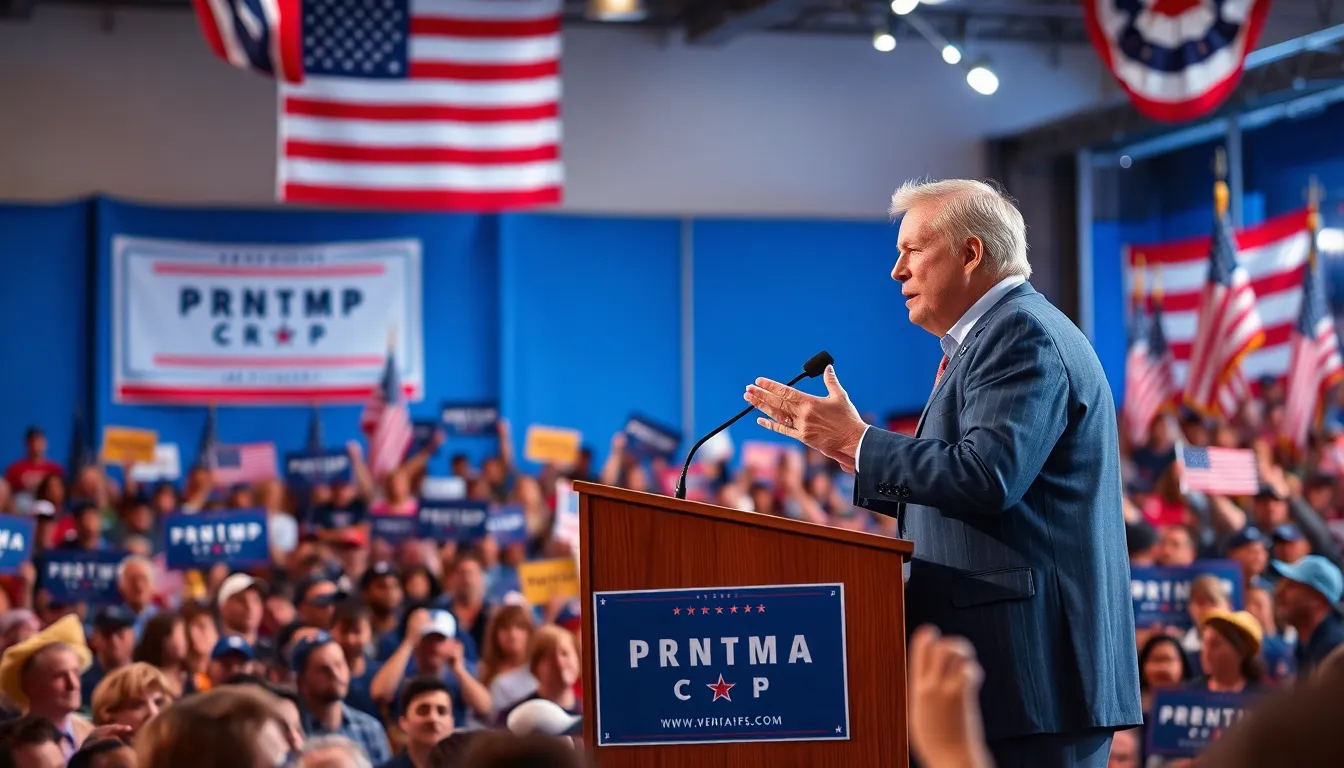Table of Contents
ToggleAs the 2024 election season heats up, all eyes are on Donald Trump and his potential return to the White House. With a loyal base and a knack for capturing headlines, he remains a formidable force in American politics. Voters are left wondering: will he secure the nomination and ultimately win the election?
Polls indicate mixed sentiments, reflecting both fervent support and significant opposition. Trump’s unique approach to campaigning, characterized by bold statements and unconventional tactics, fuels debates among political analysts and citizens alike. Navigating the complex landscape of voter sentiment, he faces challenges that could shape the outcome of the election. As the race unfolds, the question looms larger: can Trump reclaim his position, or will the tides of change favor a different candidate?
Overview of Current Political Landscape
The 2024 election season features a contentious political environment. Donald Trump maintains a robust support base, comprising loyal voters who align with his policies and messaging. His campaigning style, characterized by direct communication and controversial rhetoric, captures substantial media attention, often sparking significant debate.
Current polling data reveals a divided voter base. According to recent surveys, Trump enjoys strong backing from Republican voters but faces notable opposition from independent and undecided voters. This dynamic influences his campaign strategies, as he navigates the complex landscape to position himself favorably.
Emerging candidates, such as Ron DeSantis and Nikki Haley, pose a challenge to Trump’s frontrunner status. Their campaigns highlight issues appealing to a broader audience, potentially altering the race’s trajectory. Republican primary voters may prioritize electability over loyalty, complicating Trump’s path to the nomination.
Several factors contribute to the unpredictable nature of the race. The economy, social issues, and national security concerns are pivotal themes shaping voter opinions. Trump’s past presidential tenure and recent legal troubles further complicate perceptions. The landscape remains fluid, underscoring the uncertainty surrounding Trump’s chances in the forthcoming election.
Factors Influencing Trump’s Chances

Trump’s chances in the 2024 election rely on various factors, including public opinion and key demographics that shape voter behavior.
Public Opinion Polls
Current public opinion polls provide insight into Trump’s standing. Recent surveys indicate that Trump retains significant support among Republican voters, often polling above 50% in primary elections. However, he faces substantial disapproval ratings among Democrats and independents. Specifically, a poll from FiveThirtyEight shows Trump with a 35% approval rating overall, reflecting a polarized electorate. Polling data also reveals fluctuating numbers as new candidates emerge, emphasizing the need for agility in his campaigning strategy. His controversial rhetoric continues to elicit mixed reactions, which may affect voter turnout as the election date approaches.
Key Demographics
Key demographics play a crucial role in shaping Trump’s electoral prospects. Younger voters, particularly those under 30, show lower support for Trump, with only about 25% expressing favorable opinions. However, he maintains strong backing from older voters, especially those aged 65 and above, with approximately 60% favorability in that group. Additionally, Trump’s appeal among white working-class voters remains significant, as they represent a core element of his support base. In contrast, minority groups and women voters generally lean toward Democratic candidates, impacting Trump’s chances in swing states. The dynamics of these demographics contribute to the complexity of Trump’s campaign strategy, requiring targeted messaging to maximize appeal across different voter segments.
Trump’s Campaign Strategies
Trump employs a mix of traditional and innovative strategies to engage with voters and secure support as the election approaches. These strategies focus on impactful messaging, robust fundraising, and leveraging media visibility.
Messaging and Rhetoric
Trump’s messaging centers on themes resonating with his base, such as nationalism, economic revival, and strong opposition to perceived government overreach. He uses simple, direct language that rallies support and emphasizes his outsider status. High-energy rallies serve as a platform for his rhetoric, where he connects with attendees by addressing their concerns about inflation and crime. His controversial statements often attract media coverage, maintaining visibility in a crowded field. This approach builds a narrative of resilience and defiance against opponents, enhancing his appeal among core supporters.
Fundraising Efforts
Trump’s fundraising strategy relies heavily on small donations from his extensive supporter network. Reports indicate he raised over $70 million in the first half of 2023, highlighting the effectiveness of his grassroots efforts. Utilizing digital platforms and social media, the campaign reaches potential donors efficiently. Large-scale fundraising events with affluent backers also contribute significantly to his financial resources. He emphasizes financial transparency, presenting contributions as a direct investment in the fight against establishment politics. This dual approach ensures a steady influx of capital, vital for campaign operations and outreach efforts.
Opposition Candidates
The 2024 election landscape features several opposition candidates that could significantly influence Donald Trump’s campaign. Their strategies and platforms could reshape the dynamics within both the Democratic Party and among third-party contenders.
Democratic Contenders
Democratic contenders are focusing on various critical issues, aiming to capture voter attention away from Trump. Prominent candidates, such as Joe Biden and Gavin Newsom, emphasize unity within the party while advocating for climate change action, healthcare reform, and economic equity. Biden, as the incumbent, aims to leverage his record while addressing concerns about inflation and social justice. Newsom, gaining traction in early polls, appeals to younger voters through progressive policies and a strong social media presence. Additionally, candidates like Marianne Williamson and Robert F. Kennedy Jr. introduce alternative perspectives, potentially drawing votes from disillusioned constituents. The Democratic primaries will determine which candidate emerges with the momentum to challenge Trump effectively.
Third-Party Risks
Third-party candidates pose potential risks to Trump’s campaign, as they can siphon off votes from both major parties. Candidates like Cornel West and Marianne Williamson from the Green Party, and Robert F. Kennedy Jr. running as an independent, may attract voters seeking alternatives to mainstream choices. Their platforms focus on issues like climate action, healthcare reform, and anti-establishment sentiments, appealing to those dissatisfied with traditional candidates. Historically, third-party candidates have influenced election outcomes by drawing essential votes in critical swing states. If these candidates gain traction, they could alter the electoral map, complicating Trump’s path to victory.
Historical Context
The historical context surrounding Donald Trump’s electoral prospects reveals key insights from previous elections and lessons learned that may inform his strategies for 2024.
Previous Elections
Donald Trump’s 2016 victory marked a significant shift in American political dynamics. He gained support from disenchanted voters, particularly in swing states like Pennsylvania, Michigan, and Wisconsin, where traditional Democratic strongholds flipped. In this election, Trump’s focus on economic grievances resonated with the white working-class demographic. By contrast, the 2020 election presented challenges as Joe Biden capitalized on Trump’s handling of the COVID-19 pandemic and escalated social unrest. Biden won key battleground states, demonstrating the importance of shifting voter priorities. Trump’s overall popular vote decreased in 2020 compared to 2016, highlighting potential vulnerabilities in his quest for re-election.
Lessons Learned
Electoral outcomes offer lessons that Trump may apply to his 2024 campaign. First, understanding the preferences of critical demographics remains crucial. Trump’s base, while loyal, faces competition from emerging Republican candidates emphasizing broader appeal. Second, addressing contemporary issues, including healthcare and climate change, can resonate with a wider electorate. Post-2020 elections demonstrated the importance of moderating stances on divisive topics to attract independent voters. Third, managing public perception and media narratives is essential; Trump’s communication style can energize supporters but risk alienating undecided voters. Recognizing these dynamics positions Trump better to navigate potential challenges while reinforcing his base.
The road to the 2024 election is filled with uncertainty for Donald Trump. While he enjoys strong support among Republican voters his challenges are significant. Emerging candidates and shifting voter demographics create a complex landscape that could impact his chances.
As the election nears public opinion will continue to evolve. Trump’s ability to adapt his strategies and address key issues will be crucial. With the potential for third-party candidates to disrupt traditional voting patterns the stakes are higher than ever.
Ultimately the coming months will reveal whether Trump’s unique approach can secure him a return to the White House or if the dynamics of the race will favor his opponents.







